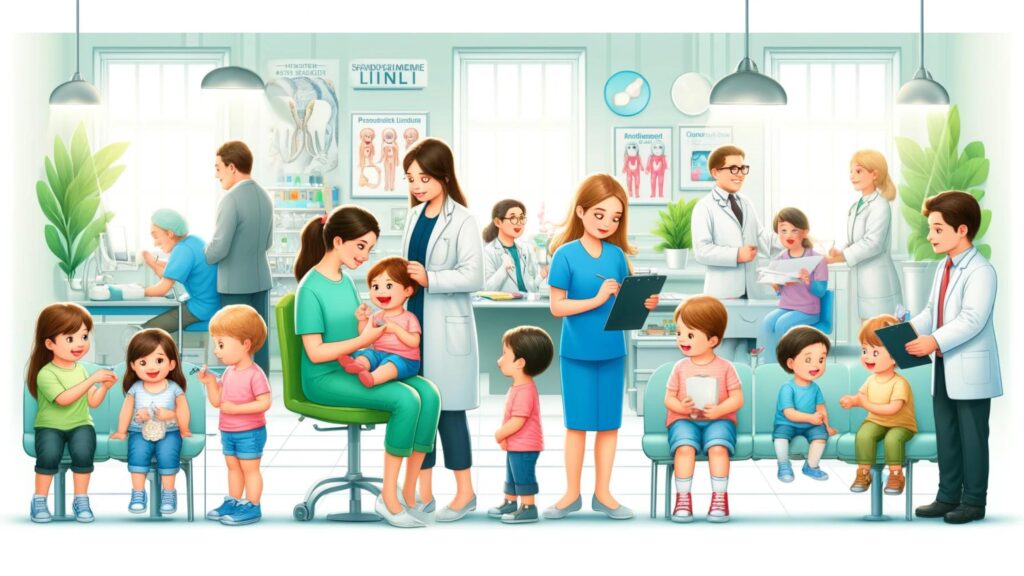Child and adolescent health can be difficult to understand. But do not worry, dear reader; these digital pages contain your compass, guide, and beacon of illumination through the murky waters of parenthood. The Ultimate Guide for Parents on Child and Adolescent Health illuminates every step of this crucial journey with clarity and insight. We look at everything from developmental milestones to nutritional needs, behavioral patterns and preventive care. Prepare to embark on a transformative journey in which curiosity turns into understanding and concern becomes empowerment. It’s time to take the helm, to navigate with confidence, and to ensure a vibrant future for your most precious treasure—your child.
- An Introduction to Child and Adolescent Health
- Understanding Adolescent Health: A Comprehensive Overview
- The significance of focusing on health during childhood and adolescence
- Key aspects of child and adolescent health
- Evolving Health Challenges for Children and Adolescents
- The study focuses on statistics and trends in children's and adolescents' health.
- How Can This Guide Help Parents Navigate Child Health Issues?
- Parents' Role in Child and Adolescent Health
- Setting the Stage: What to Expect From This Guide
- Nutrition and environmental health
- The Basics of Nutrition in Child and Adolescent Health
- Critical Nutrients for Children and Adolescents: What Parents Should Know
- Common nutritional deficiencies in children and how to avoid them
- The effects of diet on the health of children and adolescents are significant.
- Meal Planning Tips to Improve Child and Adolescent Health
- Environmental Factors Influencing Child Health
- The significance of hydration for the health of children and adolescents is crucial.
- Dietary recommendations for various age groups
- Mental and emotional well-being
- Introduction to Mental Health Concerns for Children and Adolescents
- Identifying signs of mental health issues in children
- Strategies for promoting mental health in children and adolescents
- The effects of social media on the mental health of adolescents are significant.
- Coping mechanisms for stress and anxiety in adolescents
- The role of therapy and counseling
- Developing resilience and emotional strength in children
- Resources for Parents Concerning Child and Adolescent Mental Health
- Physical Health, Safety, and Activity
- The importance of physical activity for child and adolescent health
- Recommended Exercise Guidelines for Different Age Groups
- The benefits of regular physical activity for children are significant.
- Sports and Physical Education: Balancing Competition and Health
- Preventing injuries in sports and physical activities is crucial.
- Sleep is essential for the health of children and adolescents.
- Treating common physical health issues in children
- The importance of safety and injury prevention in both the home and school setting is crucial.
- Preventive health measures and chronic management
- The impact of vaccinations on the health of children and adolescents is a topic of interest.
- Regular health screenings and checkups for children
- Dental Health's Value for Children and Adolescents
- Preventing Common Diseases in School-Age Children
- Children's chronic diseases
- Parents' role in preventive health care
- Treating allergies and chronic conditions early
- Substance Abuse Awareness and Prevention
- Comprehensive Adolescent Health Issues
- Making healthcare decisions for your children
- Cultural and socioeconomic impacts on health
- Communication strategies for discussing health with children
- How to Model Healthy Behaviors for Your Kids
- Support Networks for Parents: Finding Community and Resources
- When Should You Seek Professional Help for Your Child's Health?
- Holistic health approaches
- Legal rights and health advocacy for children
- The focus is on current issues in child and adolescent health.
- Digital wellness and screen time management
- Vaccine Updates and Emerging Health Threats
- Managing peer pressure and bullying
- First Aid and Emergency Preparedness
- Understanding health insurance and pediatric healthcare services
- Developmental milestones and early intervention
- Adolescent Body Image and Eating Disorders
- Integrating traditional and modern healthcare practices
- Parenting styles and their effects on child development
- preparing adolescents for adulthood
- FAQs about Child and Adolescent Health: The Ultimate Guide for Parents
- Conclusion

An Introduction to Child and Adolescent Health
Understanding Adolescent Health: A Comprehensive Overview
Child and adolescent health refers to a wide range of physical, mental, and emotional factors that influence the well-being of young people from birth to adolescence. This domain intricately weaves together genetic, environmental, and lifestyle factors to shape a child’s overall development. Mastery of this knowledge enables caregivers to anticipate potential health issues and fosters an environment conducive to healthy growth.
The significance of focusing on health during childhood and adolescence
Emphasizing health during childhood and adolescence is critical because it lays the foundation for a healthy adult life. Early health interventions and education can help reduce the risk of chronic diseases like obesity, diabetes, and heart disease. By prioritizing health at this stage, society helps to cultivate well-rounded adults who are physically and mentally prepared to face life’s challenges.
Key aspects of child and adolescent health
Physical fitness, nutritional intake, mental wellness, and emotional stability are all important aspects of child and adolescent health. Each element is interdependent, necessitating a balanced approach to achieve optimal development. Regular physical activity, a balanced diet, adequate mental health care, and emotional nurturing are all essential for a child’s health.
Evolving Health Challenges for Children and Adolescents
As society advances, new challenges arise in the field of child and adolescent health. While technological advancements are beneficial, they can also lead to issues such as screen addiction and cyberbullying. Furthermore, environmental changes and modern dietary habits introduce new health risks, necessitating ongoing adjustments to health advice and practices.
The study focuses on statistics and trends in children’s and adolescents’ health.
Recent statistics show significant trends in child and adolescent health, such as rising rates of mental health disorders and obesity among young people. These trends not only shed light on current health issues but also aid in forecasting future healthcare needs, guiding policymakers and healthcare professionals in their strategic planning and resource allocation.
How Can This Guide Help Parents Navigate Child Health Issues?
This guide is an essential tool for parents, providing them with the information and resources they need to effectively support their children’s health. This guide aims to provide parents with practical advice on nutrition and exercise, as well as guidance on mental health and emotional support.
Parents’ Role in Child and Adolescent Health
Parents play an extremely important role in shaping their children’s health. They serve as primary educators and role models for healthy lifestyle choices and practices. Their active participation is critical for developing routines, making informed decisions, and obtaining appropriate healthcare resources.
Setting the Stage: What to Expect From This Guide
We aim to provide a thorough exploration of the various aspects of child and adolescent health in this guide. Readers can expect comprehensive content that is both informative and useful in everyday life. The guide aims to address the nuances of health from infancy to adolescence, serving as a reliable resource at each stage of a child’s development.

Nutrition and environmental health
The Basics of Nutrition in Child and Adolescent Health
Proper nutrition is the foundation of healthy development in children and adolescents. Understanding the balance of macronutrients (proteins, fats, and carbohydrates) and micronutrients (vitamins and minerals) is required to support growth, learning, and physical activity. Parents and caregivers must understand how nutritional needs change from childhood to adolescence in order to promote optimal health outcomes.
Critical Nutrients for Children and Adolescents: What Parents Should Know
Parents should be especially aware of certain critical nutrients that their children require for good health. Calcium, vitamin D, iron, and omega-3 fatty acids are essential for bone health, cognitive development, and general well-being. Ensuring that children get enough of these nutrients can help them develop normally and resist diseases.
Common nutritional deficiencies in children and how to avoid them
Nutritional deficiencies such as iron deficiency anemia, vitamin D deficiency, and insufficient dietary fiber are common in children worldwide. Parents can help prevent this by promoting a diverse, whole-food diet and considering supplements when dietary intake is insufficient.
The effects of diet on the health of children and adolescents are significant.
Diet has a significant impact on both children’s physical and mental health. Poor dietary choices can cause obesity, type 2 diabetes, and even mental health issues such as depression and ADHD. In contrast, a well-balanced diet promotes physical growth and cognitive development, laying the groundwork for a healthy adulthood.
Meal Planning Tips to Improve Child and Adolescent Health
Effective meal planning can help children eat a balanced diet rich in essential nutrients. Include a variety of food groups in each meal, prioritize whole foods over processed alternatives, and involve children in meal preparation to teach them healthy eating habits. Planning can also help to manage food allergies and intolerances by providing safe and nutritious alternatives.
Environmental Factors Influencing Child Health
Environmental factors such as air and water quality, as well as pollution exposure, can have a significant impact on children’s health. Parents should be aware of potential hazards in their local environment and take proactive measures to mitigate them, such as using air purifiers or ensuring safe drinking water.
The significance of hydration for the health of children and adolescents is crucial.
Hydration is critical for maintaining health and optimizing physical and cognitive functions in children and adolescents. Water helps to regulate body temperature, aid digestion, and prevent constipation. Parents should promote daily water consumption, particularly during physical activities and in hot climates.
Dietary recommendations for various age groups
Dietary requirements change significantly as a child grows. Infants require nutrient-dense foods such as breast milk or formula; toddlers and young children require a well-balanced diet to support rapid growth; and teenagers require additional calories during puberty. Parents should adjust food portions and nutrient intake based on their child’s age, activity level, and growth requirements, ensuring that nutrition is appropriate for each stage of development.

Mental and emotional well-being
Introduction to Mental Health Concerns for Children and Adolescents
Understanding mental health issues among children and adolescents is critical for early detection and intervention. This section delves into the various types of mental health disorders, their prevalence, and the critical importance of identifying symptoms early in life to ensure timely and effective treatment.
Identifying signs of mental health issues in children
Recognizing the signs of mental health issues early on can be critical to ensuring that children receive the care they require. Changes in mood, behavior, academic performance, and social interactions can all serve as key indicators. This knowledge enables parents to seek professional help right away.
Strategies for promoting mental health in children and adolescents
Promoting children’s and adolescents’ mental health requires a combination of proactive communication, creating a supportive home environment, and ensuring access to professional healthcare services. Here, we focus on developing emotional intelligence and offering stability and reassurance during challenging times.
The effects of social media on the mental health of adolescents are significant.
Social media can have a significant impact on adolescent mental health by influencing self-esteem and social interactions. This section discusses both the positive and negative effects of social media and provides advice on how to effectively manage its influence in order to promote a healthy mental state.
Coping mechanisms for stress and anxiety in adolescents
Effective coping mechanisms are essential for dealing with stress and anxiety. This section covers a variety of techniques, such as mindfulness, physical activity, and creative outlets, that can help adolescents manage stress and improve their mental health.
The role of therapy and counseling
Therapy and counseling are essential for managing mental health issues in children and adolescents. The benefits of seeking professional help, various therapeutic approaches, and tailoring these interventions to the needs of young people are the topics covered in this section.
Developing resilience and emotional strength in children
Building resilience and emotional strength is essential for guiding children through the ups and downs of growing up. Teaching problem-solving skills, encouraging positive relationships, and assisting children in learning to cope positively with failures and setbacks are all ways to foster resilience.
Resources for Parents Concerning Child and Adolescent Mental Health
Providing parents with appropriate resources is critical for supporting their child’s mental health. This section provides a list of books, websites, and professional organizations that can provide helpful information and support for dealing with mental health issues in children and adolescents.

Physical Health, Safety, and Activity
The importance of physical activity for child and adolescent health
Physical activity is essential for the development and overall health of children and adolescents. Regular movement strengthens muscles and bones, lowers the risk of many chronic diseases, and improves mental health by alleviating symptoms of depression and anxiety.
Recommended Exercise Guidelines for Different Age Groups
Exercise guidelines vary by age, emphasizing the importance of matching physical activity to the child’s developmental stage. Toddlers require light play, whereas older children and teenagers may need more structured exercise routines to meet their energy needs and promote healthy growth.
The benefits of regular physical activity for children are significant.
Regular physical activity provides lifelong health benefits. It promotes a healthy weight, lowers the risk of diabetes, improves academic performance, and boosts confidence. Furthermore, starting these habits early lays the groundwork for a healthy adult lifestyle.
Sports and Physical Education: Balancing Competition and Health
While competitive sports provide numerous benefits, such as teamwork and perseverance, it is critical to balance these with overall health. Sports should be enjoyable and inclusive while also promoting physical and mental well-being, without emphasizing competition, which can lead to stress and injury.
Preventing injuries in sports and physical activities is crucial.
Preventing injuries during sports and activities is critical. This includes proper training, using appropriate equipment, and maintaining safe working conditions. Educating children and adolescents about safety measures can significantly reduce the risk of injury.
Sleep is essential for the health of children and adolescents.
Sleep is just as important as physical activity for health. Adequate sleep promotes growth, increases immune function, and enhances learning and memory. Parents should ensure that their children have a consistent sleep schedule that allows for adequate quality sleep each night.
Treating common physical health issues in children
Common physical health problems in children, such as colds, allergies, and asthma, necessitate careful management. Awareness and timely action, such as proper hygiene, medication management, and regular check-ups, can effectively manage these conditions and reduce their impact on a child’s life.
The importance of safety and injury prevention in both the home and school setting is crucial.
Ensuring safety at home and school is critical. This includes securing hazardous items, educating children on safety rules, and creating environments that reduce the risk of accidents. Educators and parents play critical roles in creating safe learning and living environments for children.
- An Introduction to Child and Adolescent Health
- Understanding Adolescent Health: A Comprehensive Overview
- The significance of focusing on health during childhood and adolescence
- Key aspects of child and adolescent health
- Evolving Health Challenges for Children and Adolescents
- The study focuses on statistics and trends in children's and adolescents' health.
- How Can This Guide Help Parents Navigate Child Health Issues?
- Parents' Role in Child and Adolescent Health
- Setting the Stage: What to Expect From This Guide
- Nutrition and environmental health
- The Basics of Nutrition in Child and Adolescent Health
- Critical Nutrients for Children and Adolescents: What Parents Should Know
- Common nutritional deficiencies in children and how to avoid them
- The effects of diet on the health of children and adolescents are significant.
- Meal Planning Tips to Improve Child and Adolescent Health
- Environmental Factors Influencing Child Health
- The significance of hydration for the health of children and adolescents is crucial.
- Dietary recommendations for various age groups
- Mental and emotional well-being
- Introduction to Mental Health Concerns for Children and Adolescents
- Identifying signs of mental health issues in children
- Strategies for promoting mental health in children and adolescents
- The effects of social media on the mental health of adolescents are significant.
- Coping mechanisms for stress and anxiety in adolescents
- The role of therapy and counseling
- Developing resilience and emotional strength in children
- Resources for Parents Concerning Child and Adolescent Mental Health
- Physical Health, Safety, and Activity
- The importance of physical activity for child and adolescent health
- Recommended Exercise Guidelines for Different Age Groups
- The benefits of regular physical activity for children are significant.
- Sports and Physical Education: Balancing Competition and Health
- Preventing injuries in sports and physical activities is crucial.
- Sleep is essential for the health of children and adolescents.
- Treating common physical health issues in children
- The importance of safety and injury prevention in both the home and school setting is crucial.
- Preventive health measures and chronic management
- The impact of vaccinations on the health of children and adolescents is a topic of interest.
- Regular health screenings and checkups for children
- Dental Health's Value for Children and Adolescents
- Preventing Common Diseases in School-Age Children
- Children's chronic diseases
- Parents' role in preventive health care
- Treating allergies and chronic conditions early
- Substance Abuse Awareness and Prevention
- Comprehensive Adolescent Health Issues
- Making healthcare decisions for your children
- Cultural and socioeconomic impacts on health
- Communication strategies for discussing health with children
- How to Model Healthy Behaviors for Your Kids
- Support Networks for Parents: Finding Community and Resources
- When Should You Seek Professional Help for Your Child's Health?
- Holistic health approaches
- Legal rights and health advocacy for children
- The focus is on current issues in child and adolescent health.
- Digital wellness and screen time management
- Vaccine Updates and Emerging Health Threats
- Managing peer pressure and bullying
- First Aid and Emergency Preparedness
- Understanding health insurance and pediatric healthcare services
- Developmental milestones and early intervention
- Adolescent Body Image and Eating Disorders
- Integrating traditional and modern healthcare practices
- Parenting styles and their effects on child development
- preparing adolescents for adulthood
- FAQs about Child and Adolescent Health: The Ultimate Guide for Parents
- Conclusion

Preventive health measures and chronic management
The impact of vaccinations on the health of children and adolescents is a topic of interest.
Immunizations are a cornerstone of public health and play an important role in preventing serious diseases among children and adolescents. Vaccines protect not only the individual child but the entire community by reducing the spread of preventable diseases.
Regular health screenings and checkups for children
Regular health screenings and checkups are essential for detecting health problems before they become severe. These checkups allow healthcare providers to monitor growth and development, administer necessary vaccinations, and offer advice on healthy living.
Dental Health’s Value for Children and Adolescents
Dental health is an essential component of overall health. Good dental hygiene should begin early in life to avoid cavities and other dental problems that can affect eating habits, speech, and self-esteem. Regular dental visits and proper daily care are critical components of oral health.
Preventing Common Diseases in School-Age Children
Common illnesses, such as the flu and colds, can disrupt learning and well-being. Proper hygiene practices, flu vaccinations, and adequate nutrition all help to support the immune system.
Children’s chronic diseases
Managing chronic diseases like asthma, diabetes, and obesity necessitates ongoing care and attention. Parents, healthcare providers, and schools must collaborate to develop management plans that include medication, dietary changes, and physical activity to ensure that children can live healthy lives despite their conditions.
Parents’ role in preventive health care
Parents play an important role in preventative health care because they lay the groundwork for healthy behaviors. Parents must educate themselves about conditions and treatments, advocate for their child’s health, and maintain a home environment conducive to well-being.
Treating allergies and chronic conditions early
Early detection and treatment of allergies and chronic conditions can reduce complications and improve quality of life. This includes recognizing symptoms early, consulting with healthcare professionals, and adhering to prescribed treatment plans.
Substance Abuse Awareness and Prevention
Adolescent health and well-being depend on substance abuse awareness and prevention. Education about the dangers and consequences of drugs and alcohol, as well as open communication between parents and children, are important strategies for preventing substance abuse.

Comprehensive Adolescent Health Issues
Making healthcare decisions for your children
Making informed healthcare decisions for children is an important responsibility for parents. This includes understanding different medical options, the consequences of treatments, and how to effectively advocate for your child’s health needs in complex healthcare systems.
Cultural and socioeconomic impacts on health
Cultural beliefs and socioeconomic status have a significant impact on health outcomes. This section investigates how these factors influence healthcare access, dietary habits, and perceptions of illness and wellness, with the goal of providing insight into how to address disparities in health outcomes.
Communication strategies for discussing health with children
When discussing health with children, clear communication is essential. This includes using age-appropriate language, being honest but reassuring, and encouraging open dialogue about their feelings and concerns to foster trust and understanding.
How to Model Healthy Behaviors for Your Kids
Children learn healthy behaviors from watching their parents. Modeling healthy eating, regular physical activity, and positive stress management techniques can instill lifelong habits that benefit their overall health.
Support Networks for Parents: Finding Community and Resources
For parents dealing with child health issues, having a strong support network can be invaluable. This section helps parents find and engage with community resources, online forums, and local groups that can provide advice, support, and camaraderie.
When Should You Seek Professional Help for Your Child’s Health?
Knowing when to seek professional help is critical for parents. This section explains how to recognize symptoms that indicate the need for medical attention, whether for physical ailments, mental health issues, or developmental delays.
Holistic health approaches
Holistic health approaches consider the child’s overall well-being, including physical, mental, emotional, and spiritual health. We discuss meditation, yoga, and alternative nutritional approaches as supplements to conventional medical treatments.
Legal rights and health advocacy for children
Parents and guardians must understand children’s legal rights in healthcare settings. This section discusses consent, privacy, and advocacy for children’s health rights, empowering parents to be effective advocates for ensuring their children receive the best possible care.

The focus is on current issues in child and adolescent health.
Digital wellness and screen time management
In today’s digital age, children and adolescents must manage their screen time to maintain their mental and physical health. This section discusses strategies for balancing online and offline activities, developing healthy digital habits, and reducing the negative effects of excessive screen time.
Vaccine Updates and Emerging Health Threats
Keeping up with vaccination schedules and being aware of emerging health threats are critical for safeguarding children and communities. This segment provides the most recent recommendations for vaccines, as well as information on how to respond to new health risks such as viruses and other infectious diseases.
Managing peer pressure and bullying
Peer pressure and bullying have a significant impact on a child’s mental health and development. This section provides advice on teaching children how to deal with social pressures in a healthy and effective manner, including resilience strategies and when to seek help.
First Aid and Emergency Preparedness
Parents and caregivers must be knowledgeable about first aid and emergency preparedness. This section explains how to deal with common injuries like cuts and bruises, as well as more serious situations like choking or allergic reactions, to ensure prompt and appropriate emergency responses.
Understanding health insurance and pediatric healthcare services
Understanding health insurance and navigating pediatric healthcare services can be challenging. This section demystifies these processes by providing practical advice on choosing appropriate coverage, understanding benefits, and accessing available healthcare services.
Developmental milestones and early intervention
Recognizing developmental milestones allows parents to track their child’s progress and development. This section discusses the key developmental stages and the importance of early intervention programs that can address developmental delays as soon as they emerge.
Adolescent Body Image and Eating Disorders
Adolescents frequently struggle with body image and eating disorders. This segment discusses how to promote healthy body image, identify signs of eating disorders, and seek effective treatment, all while cultivating a healthy attitude toward food and body image.
Integrating traditional and modern healthcare practices
Combining traditional and modern healthcare practices can provide a comprehensive approach to child health. This section looks at how integrative approaches such as acupuncture, herbal medicine, and modern medical treatments can work together to improve health outcomes.
Parenting styles and their effects on child development
Different parenting styles have distinct effects on child development. This section investigates authoritative, authoritarian, permissive, and uninvolved styles, discussing their implications and providing suggestions for taking a balanced approach that promotes healthy development.
preparing adolescents for adulthood
Preparing adolescents for adulthood is an important stage in developmental psychology. This final section provides strategies for equipping them with the necessary life skills, emotional intelligence, and practical knowledge to make a smooth transition into responsible and independent adults.
FAQs about Child and Adolescent Health: The Ultimate Guide for Parents
1. What are the most important aspects of pediatric and adolescent health?
Answer: The most important aspects are physical health (nutrition, exercise, and sleep), mental health (emotional support and stress management), preventive care (vaccinations and regular check-ups), and safety.
2. How do I make sure my child eats a well-balanced diet?
Answer: Offer a variety of foods, such as fruits, vegetables, whole grains, protein sources, and dairy. Limit sugary snacks and drinks, and get your child involved in meal planning and preparation to encourage healthy eating habits.
3. What are some common indicators of mental health issues in children and adolescents?
Answer: Common signs include changes in mood or behavior, withdrawal from social interactions, poor academic performance, changes in eating or sleeping habits, and feelings of hopelessness or worthlessness.
4. How much physical activity do children and adolescents require?
Answer: The World Health Organization recommends that children and adolescents aged 5 to 17 engage in an average of 60 minutes per day of moderate to vigorous intensity, mostly aerobic, physical activity during the week.
5. What should I do if I believe my child is a victim of bullying?
Answer: Discuss your child’s experiences, listen without judgment, and assure them of your support. Document bullying incidents and report them to your child’s school or the appropriate authorities for intervention.
6. What can I do to help my child manage stress?
Answer: Encourage open communication, teach stress-management techniques like deep breathing, meditation, or exercise, and ensure a healthy balance of academic and recreational activities. Professional assistance may be required if the stress is severe.
7. At what age should mental health education start?
Answer: Mental health education should begin early, tailored to the child’s developmental stage. Even young children can learn basic concepts about emotions and how to express them.
8. How do vaccinations benefit child and adolescent health?
Answer: Vaccines protect against a variety of infectious diseases that can cause serious health problems. They promote immunity and are an essential component of preventive health care.
9. How important is sleep to children and adolescents?
Answer: Sleep is essential for physical growth, brain development, and emotional regulation. Inadequate sleep can cause problems with mood, behavior, cognitive abilities, and overall well-being.
10. How should I teach my child about health and wellness?
Answer: Set an example, provide age-appropriate information about various aspects of health, participate in healthy activities together, and foster an environment that promotes well-being and healthy choices.
Conclusion
Child and adolescent health is critical for building a solid foundation for long-term well-being. This ultimate guide provides parents with the knowledge and strategies they need to successfully navigate the complexities of today’s health challenges. Staying informed allows parents to actively contribute to their children’s physical, emotional, and mental health, ensuring a successful future. Explore our related posts today to gain more insights and tips for improving your child’s health.

